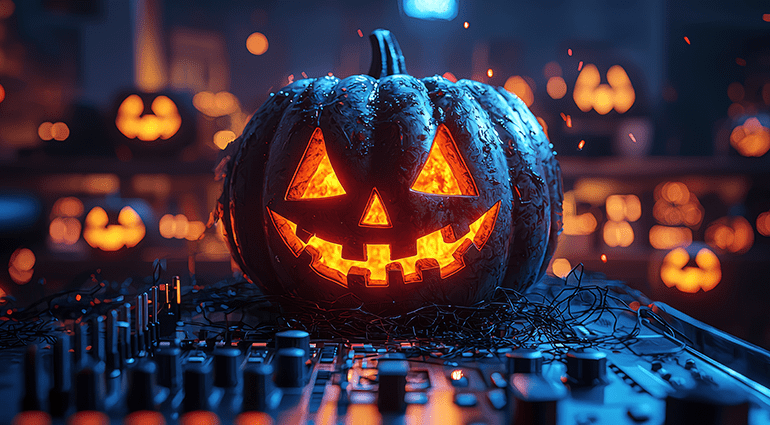
Always wanted to make scary music but never tried?
Maybe you’re… too scared?😱

Wearing only a costume on October 31st is for kids, time to take it to the next level and compose a spooky soundtrack to accompany your Halloween party. “It’s impossible” you say? Read on and you’ll see that it’s more attainable than you think. In this article we’ll discuss the tricks and gadgets that some of the most reputable composers of horror soundtracks use. Take a deep breath and get ready to scream (or hear the screams of your audience). ?
Bowed instrument techniques
With bowed instruments you can create a lot of spooky effects, whether it’s with the violin, viola, cello, or double bass, a few special techniques can give anyone goosebumps… Get ready to learn some Italian: Glissando is the technique where you slide your fingers up and/or down the strings while bowing steadily.
- Skulls Violin Set 4/4
- HBV 990SKL 4/4 Electric Violin
Col Legno is when you turn the bow upside-down and tap the strings with it creating a sound of “clicking bones”. Tremolo, also known as “shivering bow” is when you rapidly bow back and forth with a slight movement of the wrist or fingers creating tension and/or apprehension in your music. Try these yourself and see what kind of effect they create for you and don’t be afraid to experiment. And while you’re at it, why not use a scary looking instrument?
- Rockabilly Psycho Slap bass
See the video below for a violin demonstration by Diane and for more spooky ideas:
You are currently viewing a placeholder content from YouTube. To access the actual content, click the button below. Please note that doing so will share data with third-party providers.
Any spooky pedals out there?
To give your scary guitar, bass or keyboard music even more depth, some delay pedals can create this kind of filtered delay effect that creates the creepiest atmosphere. One trick is to filter out the low frequency of the delay… We recommend the ARP-87 from Walrus Audio for this, with its four programs: digital, analog, lo-fi and slapback or the Allpedals Devil Triad Essentials OD/BST
- Walrus Audio ARP-87
- Allpedal Devils Triad Essentials OD/BST
The analog and lo-fi settings, especially, can sound pretty creepy if you’re playing minor scales or chords. If you’re willing to spend a little more, the Strymon Timeline is a fantastic and very versatile delay pedal that can do pretty much anything in the delay world.
- Strymon Timeline
Listen, especially to “Sound #5” in the video below ? With certain settings you can get sounds that send shivers down your spine:
You are currently viewing a placeholder content from YouTube. To access the actual content, click the button below. Please note that doing so will share data with third-party providers.
The Theremin
To make even the most hardcore Halloween / horror fans shake in their boots we can’t pass up the theremin, the oldest electronic instrument in history, which you don’t even need to touch to use.
- Moog Theremini
This fact alone gives it some mystery. Thomann carries a few different models of the theremin, with which you can create some really retro-sounding ghost-like or alien-like sounds. It immediately sounds eerie, the trick is learning how to control it properly. All we can recommend is hours, weeks or months of practice (if you’re brave enough)!
- Widara Distant Voices Theremin
- Doepfer A-178 Theremin Module
In the video below the fantastic Carolina Eyck demonstrates how the instrument works and what sounds you can get out of it. Skip to 13:00 to learn how effect pedals (delay, chorus, octave and looper) can be used with the theremin to create the spookiest sounds ever! ?
You are currently viewing a placeholder content from YouTube. To access the actual content, click the button below. Please note that doing so will share data with third-party providers.
Minor chords & dissonance
The tools you use don’t matter in the grand scheme of things. If you’re using creating tonal music (music with a key) any instrument can create spooky or scary sensations. The tricks are in the intervals you use. We all know that minor keys or chords usually cause more “sad” or “melancholic” emotions to arise, and this could be one way of getting closer to scary. But there are certain intervals (the difference in pitch between two notes) that can also “disturb” us in certain ways. There is one, in particular, which, in Medieval times was actually illegal to play, called the Devil’s Interval.
The Devil’s Interval – diabolus in musica 👹
Okay, in plain terms, the interval is simply called the “tritone” and spans three whole tones. In other words, the two notes are six semitones apart, for example, from D flat to G, from A to E flat, or from F to B. It’s also referred to as an augmented fourth and typically also as a diminished fifth. The devil’s interval, which for our purposes can be particularly effective high in the range, got its name for several reasons. First, it sounded unpleasant and surprising to listeners. Then, the interval is difficult to sing. According to various sources, it was supposedly even banned by the Catholic Church during the Middle Ages.
You are currently viewing a placeholder content from YouTube. To access the actual content, click the button below. Please note that doing so will share data with third-party providers.
However, that is long outdated, and there are many well-known pieces and songs that feature the tritone. Starting with J.S. Bach, Vivaldi, or Beethoven, the interval has since made its mark on rock music and especially metal. Famous examples include the beginning of Purple Haze by Jimi Hendrix, the main riff of Enter Sandman by Metallica, or the entire eponymous album Diabolus in Musica by Slayer. You can even hear the devil’s interval in the theme music of The Simpsons. Okay, that’s probably no coincidence, and here we come full circle to Halloween, since the series from Springfield is known for its annual Halloween specials.
Check out the video below for examples of the Devil’s Interval and some “Death chords” as a bonus:
You are currently viewing a placeholder content from YouTube. To access the actual content, click the button below. Please note that doing so will share data with third-party providers.
Synthesizers
Of course, one of the most readily used instruments for creating creepy atmospheric music, especially for high-budget films, is the synthesizer. Let’s take John Carpenter for instance, he uses modular analog synths to create some of the most memorable horror film scores in the history of horror films. Remember the theme from Halloween (1978)? He used the legendary (and super expensive) Moog IIIP Modularsystem Synthesizer along with a ribbon controller and a 1970s Mini Moog. These are hard to find today, unless you have tens of thousands to spend, but there are alternatives from Moog in our shop. With these synthesizers, and the know-how, you can create spooky masterpieces. Get practising!
- Moog IIIP Modularsystem Synthesizer
- Ribbon controller from Doepfer
- 1970s Mini Moog
You are currently viewing a placeholder content from YouTube. To access the actual content, click the button below. Please note that doing so will share data with third-party providers.
Did you enjoy our tips on how to make scary sounds? What variations do you know? There are many many other ways of making scary sounds, which is your favourite? Let us know in the comments below. Have a safe and happy Halloween!
🎃👻
2 comments
Leave a Reply
You are currently viewing a placeholder content from Facebook. To access the actual content, click the button below. Please note that doing so will share data with third-party providers.
More InformationYou are currently viewing a placeholder content from Instagram. To access the actual content, click the button below. Please note that doing so will share data with third-party providers.
More InformationYou are currently viewing a placeholder content from X. To access the actual content, click the button below. Please note that doing so will share data with third-party providers.
More Information

















Lyla says:
What the fuck I am a kid in fifth grade and me and my friend says bad words like bitch